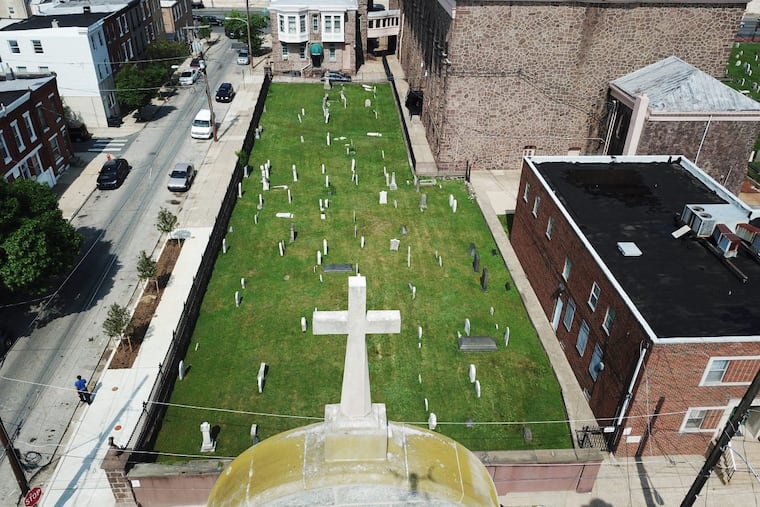Philip Duffy let 57 immigrants be forgotten in a mass grave, then his burial site was forgotten, too. Until now
Philip Duffy brought 57 Irishmen to work on the railroad outside Philly in 1832. All ended up dead in a mass grave at a stretch of land named after him.

Philip Duffy was an Irishman and a railroad contractor who will forevermore be linked to Duffy's Cut, a stretch of land just outside Philadelphia where he let 57 Irish immigrants — some of whom were murdered and some of whom died of cholera — be buried in a mass grave in 1832.
And then, as far as history can tell, he kept quiet about it.
If not for brothers William and the Rev. Frank Watson, two historians who uncovered secret documentation about the mass grave in 2002, the story of the 56 men and one woman buried near a stretch of the old Philadelphia & Columbia railroad line in Malvern would have gone untold and forgotten.
With history the great leveler that it is, Duffy's final resting place was forgotten, too. Until now.
Duffy's grave — which was not marked with a tombstone — was recently pinpointed at the cemetery at St. Anne's Parish, on Lehigh Avenue and Memphis Street in Port Richmond, thanks to work from the St. Anne Historical Committee and other researchers.
William Watson, one of the brothers who uncovered the documentation about the mass grave at Duffy's Cut, called the discovery "an amazing turn of events."
>> READ MORE: Promising discovery in 1830s deaths of Irish rail workers on the Main Line
"We always thought that a fire at the turn of the century caused the collapse of the tombstones, and that's why the grave was lost," said Watson, a professor at Immaculata University. "It turns out his family didn't want him to have a tombstone because they thought it would be desecrated."
But Duffy's going to get a tombstone anyway. In a Saturday ceremony at St. Anne's, Duffy's grave will be dedicated and a tombstone, donated by Laurel Hill Cemetery, will be installed. Watson and his twin brother will give remarks — even if, as William Watson said: "I don't think very fondly of him."
Duffy isn't believed to have been responsible for the cholera outbreak that killed immigrants just eight weeks after he brought them to the United States from Ireland to work on the railroad line, which is now the Philadelphia-Pittsburgh main line. Nor is he believed to have been complicit in the murders, which may have occurred at the hands of anti-Irish vigilantes. But his deafening silence about both was part of the reason their stories were almost never told.
"He couldn't have stopped the cholera outbreak or the massacre, but he could have told their stories and commemorated their heroism. Instead he wiped his feet of it," said Watson. "I do think he put his career and the advancement of the railroad ahead of the men at the site."
In 2012, a funeral service was held at Laurel Hill for four men and a washerwoman whose murdered remains were found by the historians at Duffy's Cut. The remains of two others were returned to Ireland for burial.
>> READ MORE: Long-forgotten dead of Duffy's Cut get proper rites
Watson said his team would resume excavation work at the site soon.
"We know the first seven were murdered, without a doubt … and I think that you're talking about a lot more who were murdered," he said. "This may be the biggest mass murder in Pennsylvania history."
A second newly discovered grave
A second gravestone will be dedicated Saturday at St. Anne's to mark the final resting place of Sgt. Michael Trainer, a Battle of Gettysburg veteran from the 69th Pennsylvania Volunteer Infantry, whose grave was also recently discovered at the parish. Members of the 69th Pennsylvania Civil War Reenactment Group will be on hand to mark the occasion.
Over the last seven years, the St. Anne Historical Committee has worked to uncover and organize records from the church, which was founded in 1845 as a place of worship for Irish Catholics. Using logs, burial records, and attendance tallies, researchers located unmarked graves, which included 53 Civil War veterans, according to Russ Wylie, the committee's president emeritus.
"Many of the Irish immigrant soldiers that made up a large portion of the Union Army, their families didn't have the resources to buy them a gravestone, so they were just buried," Wylie said.
With most of the research and mapping of the cemetery at St. Anne's now complete, Wylie said, he's not aware of any other notables who may be buried there.
"However, the church has been serving the Port Richmond area for over 170 years, and there is always a possibility that more famous Philly characters are buried in the cemetery," he said.